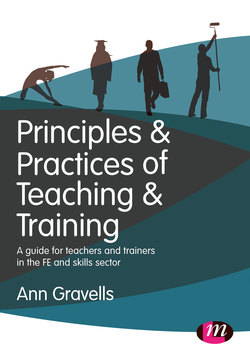Читать книгу Principles and Practices of Teaching and Training - Ann Gravells - Страница 6
ОглавлениеCONTENTS
The further education and skills sector
Qualifications and standards for teachers and trainers
Study skills, academic writing and referencing
Obtaining a teaching position and progressing further
Promoting appropriate behaviour and respect
Creating and maintaining a safe, supportive and effective teaching and learning environment
Legal, regulatory requirements, and codes of practice
2 Factors contributing to learning
Teaching and learning environments
Learner age ranges and modes of attendance
Learning preferences and styles
Teaching and learning theories, principles and models
Teachers and trainers
Learners’ needs and points of referral
Barriers to learning
Learning support assistants
Initial and diagnostic assessment
4 Planning and designing teaching and learning programmes
The curriculum
Aims and objectives
Schemes of work
Session plans
Individual learning plans
Induction, icebreakers and ground rules
5 Managing and facilitating learning
Managing learning
Facilitating group learning
Facilitating individual learning
Coaching and mentoring
Functional skills and wider skills
Teaching and learning approaches and activities
The importance of communication
Reading, writing, speaking and listening
Verbal and non-verbal communication
Barriers to communication
Interpersonal and intrapersonal skills
Theories of communication
Physical resources
People as resources
Creating and adapting resources
Meeting the individual needs of learners through resources
Visual presentations, handouts and worksheets
Evaluating resources
8 Technology enhanced teaching and learning
The role of technology in teaching, learning and assessment
Learning technology
E-learning
Social networking and social media
Using digital technology
Online safety and security
Equality and diversity
Inclusive practice
Differentiation
Culture
Discrimination
Demonstrating good practice
The purpose of assessment
Assessment both on- and off-the-job
Assessment types and methods
Questioning techniques
Minimising risks
Making decisions and providing feedback
Quality assurance in further education and skills contexts
Internal quality assurance
External quality assurance
Minimising risks
Appeals, complaints and disputes
Standardisation of practice
12 Evaluating and improving practice
Evaluation in further education and skills contexts
Obtaining data and gaining feedback
Self-evaluation
Reflective practice
Theories of reflective practice
Continuing professional development
13 Delivering a micro-teach session
Preparing for the session
Planning the session
Facilitating the session
Assessing learning, making decisions and giving feedback
Receiving feedback
Evaluating the session
What is teaching practice?
The minimum core
Preparing to be observed
During the observation
After the observation
Evidencing teaching practice
1 Abbreviations and acronyms
2 Checklist for teachers and trainers
